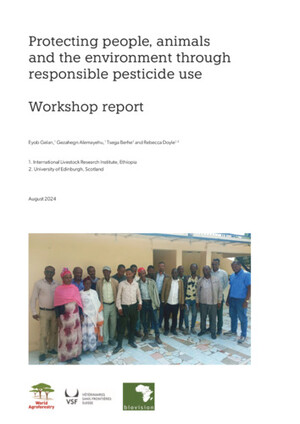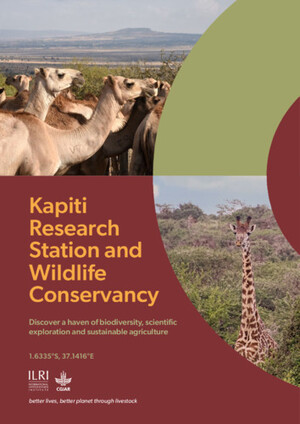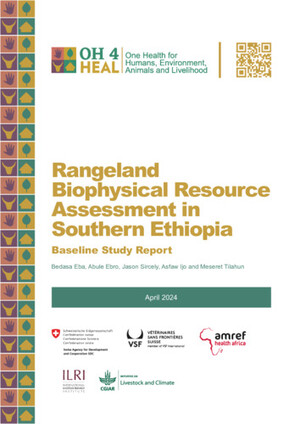
CLEANED documentation: Conceptual overview of CLEANED and parameterisation of a CLEANED tool for Lushoto, Tanzania
Abstract
This companion document provides supporting information about the “Comprehensive Livestock
Environmental Assessment for improved Nutrition, a secured Environment and sustainable Development along livestock value chains” (CLEANED) tool and how it has been parameterised for use in Tanzania, including a description of the study area. CLEANED is a spatial multi-dimensional and rapid environmental impact assessment framework of livestock value chains. It was developed to identify potential positive and negative environmental impacts of proposed practices or development interventions, and a
ddresses the current gap in environmental assessment methods by being a rapid, multi-dimensional assessment tool including various spatial and temporal scales. For the “Researchand Learning for Sustainable Intensification of Smallholder Livestock Value Chains”(ResLeSS) project, CLEANED has been
applied in Burkina Faso, Ethiopia and Tanzania.
The CLEANED model focuses on environmental impact of livestock value chains associated
with feed production, which constitutes the major source of environmental impacts related to livestock value chains.Environmental impact is categorized into four key impact dimensions that are used as proxies to assess environmental change. Three dimensions, I) water, II) land/soil and III) biodiversity, are impacting the local environment, while the fourth, IV) greenhouse gas (GHG) emissions, is used to assess the contribution to global climate change (CC). The tool uses pixel based modelling with spatial input data to generate output maps showing the distribution of environmental change in relation to baseline conditions. As such the CLEANED tool can be seen as a way to give meaning to the many openly available but difficult to interpret GIS data for the context of transforming livestock value chains.
In Tanzania, the focus is smallscale dairy production in the district of Lushoto, Tanga Region, Tanzania. Lushoto is located is in the mountains near to the Kenyan boarder. The reconnaissance work has shown that smallholders keep cattle for dairy in three different systems: extensive in the lowland, semi-intensive and intensive in the highlands. Yet, discussion about future developments in the first ResLess workshop have pointed out that in all three systems smallholders are trying to improve the breeds. This is why the CLEANED Tanzania works with breeds, namely preliminary local breeds, cross breeds (with 65-85% exotic genes), almost pure breed (more than 85% exotic breed). Local breeds are mainly found in t
he lowlands and are mainly fed on natural grasses and some crop residue. The cross-breeds are found in the highlands and are mainly fed on a mix of natural grass, crop residues and a bit of concentrate. In this system the main issue is the feed shortage in the dry season, which can be addressed with the production of hay and silage. Also planted feed, which has higher nutritional value than crop residues could be used to improve milk productivity per cow. The almost pure breed is a category is only marginal
ly existent in Lushoto in the current situation. These animals needs much more care and hardly feed on natural grasses and crop residues, but mainly on planted fodder and concentrates.
Initial livestock population numbers to parameterise the ‘base run’ in CLEANED (a scenario that represent the present day situation) are calculated for the three categories using a triangulation between the participatory GIS activities in the first workshop, freely accessible spatial data layers and household survey and verified against provincial livestock population statistics from FAO and data available from the district office and Demographic Health Surveys (DHS). To make it easy and fast for users to build scenarios of livestock production in Lushoto (how to produce in each category and how many animals per category) in a workshop setting, a set of ‘vignettes’ was produced that describe credible combinations of feed baskets with animal productivity for each animal category representing two or three different livestock management options within each production category. These vignettes are pre-
set within the CLEANED tool code, so that the non-expert can develop credible scenarios.
This document accompanies the report of the second ResLeSS workshop in Lushoto, Tanzania, titled “
Exploring alternatives for livestock production in Lushoto, Tanzania: Playing the Transformation Game”
, which presents the design and results of the workshop.
Citation
Pfeifer, C., Morris, J., Soka, G., Moses, E. and Ensor, J. 2018. CLEANED documentation: Conceptual overview of CLEANED and parameterisation of a CLEANED tool for Lushoto, Tanzania. York, UK: Stockholm Environment Institute.










